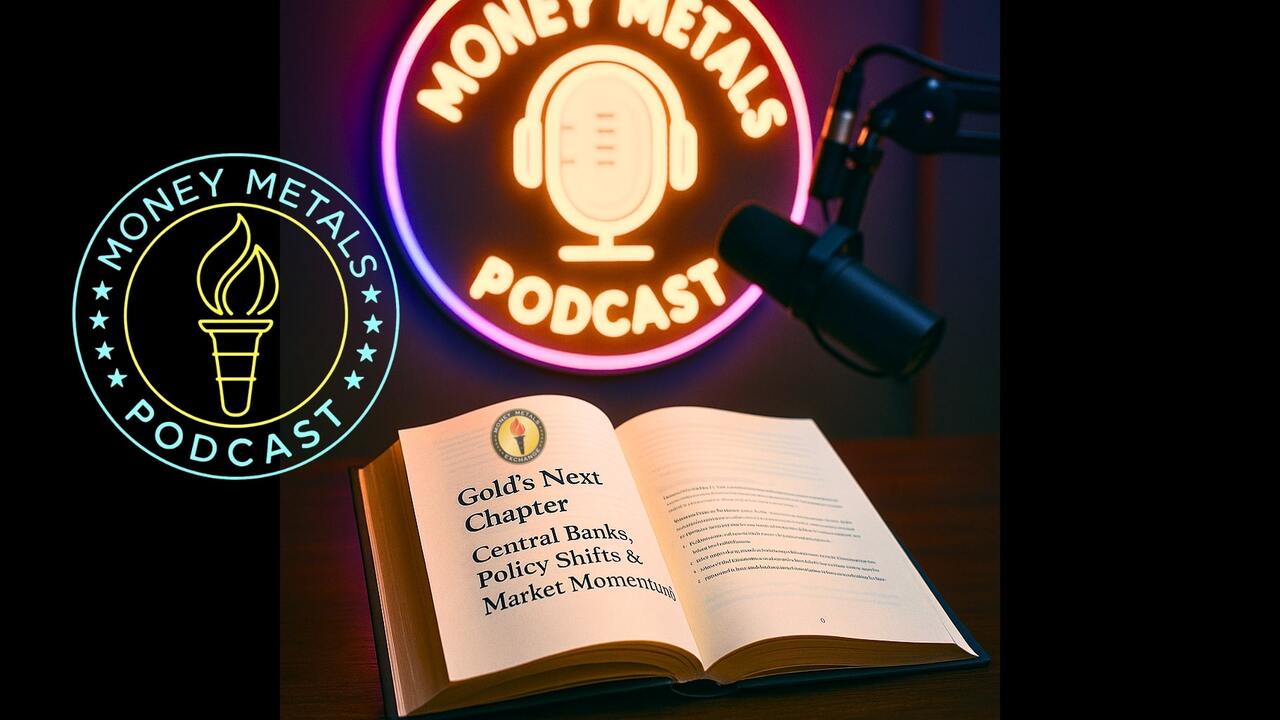(Money Metals News Service) In a recent episode of the Money Metals podcast, host Mike Maharrey sat down with Joseph Cavatoni, aka Joe Cavatoni, market strategist for the World Gold Council, to explore current trends in the gold market, long-term investment strategies, central bank buying, and key legislative efforts aimed at integrating gold more fully into the financial system.
Cavatoni, a veteran of BlackRock and now a leading voice at the World Gold Council, provided insights grounded in both institutional strategy and global market dynamics.
(Interview Starts Around 7:28 Mark)
From Fringe to Financial Fixture: The U.S. Wakes Up to Gold
Over the past eight years, Joseph Cavatoni has seen a significant transformation in how Americans perceive gold. Once considered a fringe or “gold bug” asset, gold has gained mainstream traction—particularly among institutional investors.
“When I joined the Council eight years ago, the U.S. wasn’t very plugged into gold,” said Cavatoni. “Now we’re seeing greater awareness and a real desire to understand gold’s role in a portfolio, not just at the consumer level but at institutions like BlackRock.”
The mainstreaming of gold is increasingly evident. Global firms now recommend gold as a hedge in their strategic portfolio guidance, recognizing its value during inflationary and geopolitical uncertainty.
Record Highs & Consolidation: What’s Next?
Gold reached a historic milestone in April 2024, peaking at $3,500 per ounce. Since then, prices have traded in a consolidation range of $3,200 to $3,400, signaling a potential cooldown after 40 record highs in 2024 alone.
Cavatoni explained that while gold’s average historical return since the end of the gold standard in 1971 is about 8% annually, recent returns are far above average—25–26% year-to-date. He attributes the sharp price growth to global uncertainty, geopolitical risk, and a flight to safe-haven assets.
“We’re likely in a consolidation phase,” he said. “Investors, central banks, and consumers are holding—not selling. Jewelry demand is weaker due to high prices, but investment demand remains strong.”
Central Banks Are Driving Demand—And It’s Not Slowing Down
Central bank gold buying has emerged as a structural force in the market. For three consecutive years, central banks have purchased over 1,000 metric tons annually, amounting to 20% of global gold demand.
In the World Gold Council’s 8th annual central bank survey, a record 73 banks responded. Key findings included:
- Nearly 50% of central banks plan to increase gold reserves in the next 12 months—up from 29% last year
- 95% expect global central bank gold reserves to grow—up from 80% the prior year
- 76% said they are increasing gold exposure at the expense of fiat currencies like the U.S. dollar and the euro
This shift reflects a desire to diversify away from dollar-based assets, not eliminate them. “It’s not de-dollarization,” Cavatoni noted, “but a rebalancing of reserves toward real assets with strategic characteristics.”
Fiscal Reckoning and Gold’s Strategic Role
The conversation turned to U.S. fiscal policy and rising debt. Cavatoni warned that markets are beginning to price in long-term structural risks, including:
- $37 trillion in U.S. national debt
- The approaching 2030 Social Security funding gap
- Political dysfunction and short-term policymaking
“These systemic risks are precisely why gold makes sense as a strategic long-term hold,” said Cavatoni. “Real assets are essential when you’re dealing with this kind of sovereign risk.”
Public Policy Initiatives: Gold Access, Supply Chain Reform & State-Level Action
The World Gold Council is actively engaged in multiple legislative efforts
Senate Bill 989 – Precious Metals Parity Act
This bipartisan bill would allow mutual funds to hold gold and other precious metals without punitive tax treatment, enabling them to be classified as “good income” assets.
If passed, it could open the door for 401(k)s and retirement funds to more easily incorporate gold as part of a diversified portfolio.
“It’s a small bill but strategically important,” said Cavatoni. “It allows more investors exposure to gold without tax penalties.”
Artisanal Mining & Supply Chain Legitimacy
High gold prices have drawn criminal organizations, including the Wagner Group and drug cartels, into artisanal mining operations across developing regions. The Council is working with G7 and G20 nations to:
- Promote legitimate, trackable supply chains
- Support local economies and miners
- Reduce child labor and mercury use
- Create trusted gold buying programs with central banks
State-Level Sound Money Initiatives
The Council is also supporting efforts at the state level in places like Texas, Florida, Utah, Wyoming, and Arizona where governments are:
- Eliminating sales tax on bullion
- Recognizing gold and silver as legal tender
- Creating payment systems backed by state gold depositories
Cavatoni emphasized that state treasurers are often cautious, preferring flexibility over mandates, but many are beginning to explore how gold can stabilize their reserves and offer citizens alternatives for savings and payment.
Federal Capital Gains Reform? Not Yet.
While many gold advocates push for capital gains tax reform, Cavatoni says that fight is on pause. With the federal government seeking revenue increases, removing the 28% collectibles rate may be off the table for now.
Instead, the Council is focused on expanding portfolio access via mutual funds, which could generate net revenue and attract broader ownership—paving the way for future tax reform.
Final Thoughts: Gold as a Long-Term Compass
In closing, Cavatoni encouraged investors to avoid being swept up in daily news cycles and focus on gold’s long-term strategic value.
“The short-term is messy,” he acknowledged. “But the fundamentals—currency debasement, fiscal reckoning, geopolitical uncertainty—make gold a smart and necessary part of any diversified portfolio.”
For continued insights, he recommended visiting:
- gold.org – for global policy and Council initiatives
- goldhub.com – for data, trends, surveys, and market research
He specifically highlighted the upcoming Q2 2025 Gold Demand Trends report and a recent release outlining historical sell-offs and warning signals for gold prices. Joe Cavatoni can be found on X (formerly Twitter) via @JCavatoni_WGC.
Call to Action
To begin building your gold and silver portfolio—starting with as little as $100/month—call Money Metals Exchange at 1-800-800-1865 or visit MoneyMetals.com.

